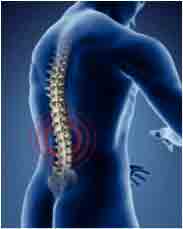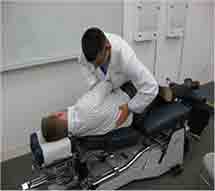|
Chiropractic TreatmentSpinal manipulating for lower back painby Michelle Botes age-well.org > spinal column and back pain > chiropractic treatment 
Chiropractic treatment is considered a non-surgical, drug-free treatment for back pain (lower and middle), neck pain, headaches and all other musculoskeletal conditions. The trained medical professional performing chiropractic treatment is called Doctors of chiropractic (DC) or, more commonly, chiropractors.
What is chiropractic treatment?The word chiropractic is derived from Greek and means “to perform with the hands”. A chiropractor will use manual manipulation and mobilization in an effort to re-align the vertebrae in the back. He or she will use short, quick movements to ‘crack’ the back in order to restore functionality, increase range of motion and decrease irritation on the surrounding nerves and soft tissue. In some instances, the chiropractor may also stretch some of the muscles and joints surrounding the back to further improve mobility. Other than a physiotherapist, whose focus is more on soft tissue, a chiropractor’s main focus will be realignment of the spine, stemming from their belief that most pain are caused by misalignment of the vertebrae in the back. These misalignments might have been caused by an accident, normal wear and tear, wrong movement or over use of the back. A chiropractor will also educate their patients in ergonomic and correct movement when lifting, moving, standing and walking in order to prevent re-occurrence of pain or misalignment. Techniques and Treatments
A chiropractor uses various techniques in order to establish the severity of a patient’s misalignment. During a consultation, a DC will collect information from a client’s medical history, neurological and physical examinations and use various tools to determine which approach will be best suited. Typically during a consultation, the chiropractor will start with a case history determining where the pain is located, duration of the pain and what factors worsen or ease the pain. As most chiropractors have a holistic approach, they will ask questions related to diet, exercise, emotional state and lifestyle habits. A physical examination follows the consultation during which the chiropractor will ask the patient to perform certain movements. In the case of lower back pain, movements could include bending forwards, backwards and to their sides. The difficulty or ease of these movements will indicate to them the exact area in the lower back where the misalignment occurs. Very rarely s/he might request x-rays. The most important technique being used by a chiropractor is manual manipulation. S/he uses their hands to quickly rotate, extend or move a joint further than a person can do on themselves. In most cases, an audible ‘crack’ is heard. Contrary to what you might have heard, this is not the sound of anything breaking or tearing, but merely gas escaping from the vacuum that exists within joints. These movements will be done on several joints within the back and hips. Some light stretching or massage might follow the manipulation treating the surrounding soft tissue. Once you are free from pain after a series of manipulation and mobility treatments, the chiropractor will give you some strengthening and stretching exercises to do. This will ensure the mobility of the joints and strengthen the muscles supporting the lower back to attempt to avoid reoccurrence of the pain. In certain cases you might be advised to use special tools such as pillows or back support cushions that could ease back pain. Safety, efficacy and side effectsThere is much debate about the safety of chiropractic. The biggest concern is for manipulation of the neck due to the fact that two main arteries run down the neck and that in some rare instances manipulation might cause strokes. On the other hand, chiropractic has been around for a very long time and have been used quite successfully by many patients. Research in chiropractic are ongoing, especially chiropractic on the lower back, and there are numerous reports claiming that most patients experience some degree of pain relief following a chiropractic manipulation. Every medical intervention has its side effects and like most non-invasive methods, the side effects of chiropractic are minimal. The most commonly reported side effects are tenderness, mild pain or stiffness at the area of manipulation. These discomforts usually dissipate in 24 hours after treatment. Ice packs or over the counter pain medication is usually effective in treating post-treatment side effects. How to choose a chiropractorIf you are considering chiropractic as treatment, there are a number of questions you should ask, including, but not limited to, the following:

If the main cause of your back pain is caused by a structural imbalance or misalignment, chances that a chiropractor might help you are good. But do make sure that you seek out a trained, licensed practitioner. If you have been suffering of recurring back pain for many years, you might have come to learn that prevention is better than cure. Once pain occurs, it can render a person immobile for a while, causing much frustration. Regular exercise, strengthening and supporting the lower back is key to prevent re-occurrence of lumbago. A little daily discipline in that regard might save you a lot of time, discomfort and frustration in future. Sources: age-well.org > spinal column and back pain > chiropractic treatment Top of chiropractic-treatment |
Subscribe to E-zine
Table of Contents
|
|
|
The Spinal Column & Back Problems
|
|
The Human Spine
|
|
Back Problems
|
|
Lower Back Pain
|
|
Herniated Disc
|
|
Piriformis Syndrome
|
|
Piriformis Test
|
|
Piriformis Exercises
|
|
Chiropractic Treatment
|
|
Acupuncture for Lumbago
|
|
Back Care
|
Related Issues
|
Osteoarthritis
|
|
Joint Replacement
|
|
Osteoporosis
|
|
Drink Plenty of Water
|
|
Incontinence
|
Free Back Pain Relief Offers
Free Back Pain Relief Offers

Links to Related Pages
Links to Related Pages













